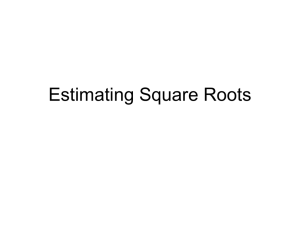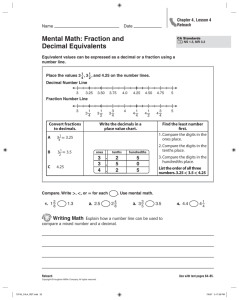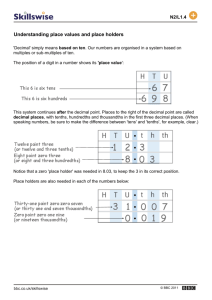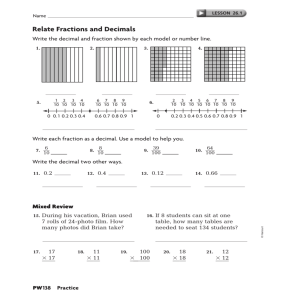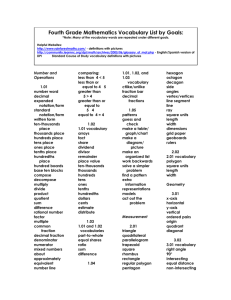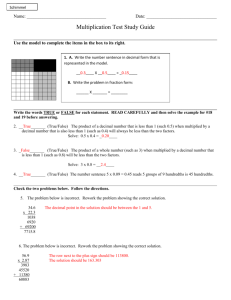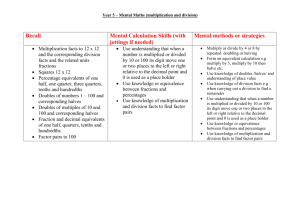Transcription
advertisement
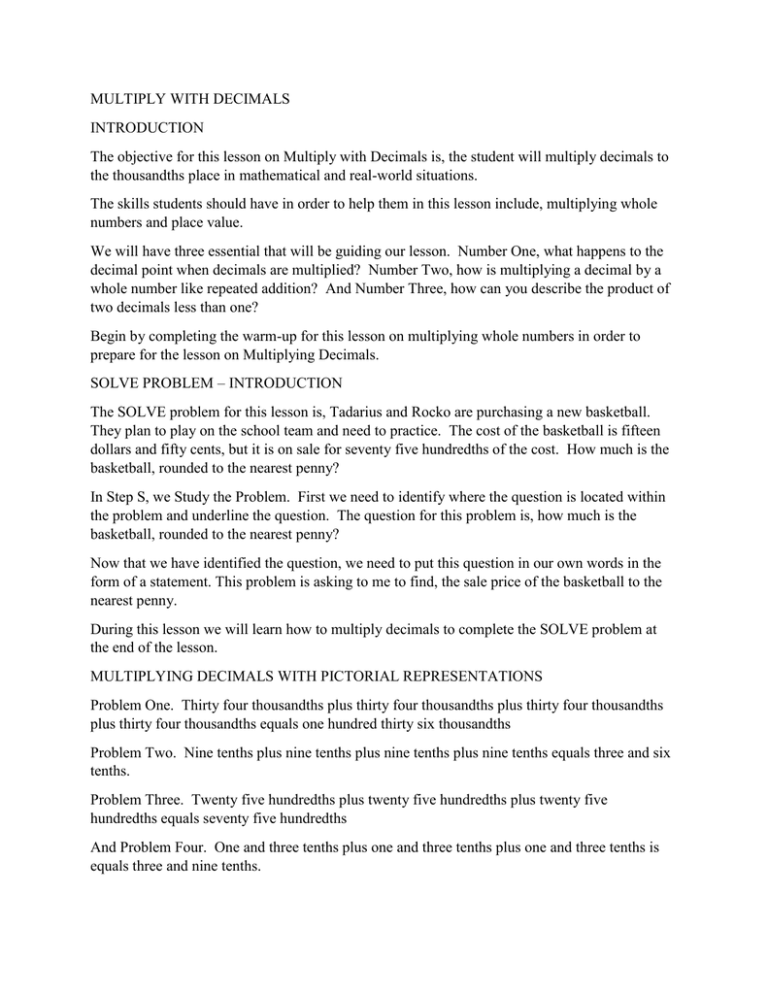
MULTIPLY WITH DECIMALS INTRODUCTION The objective for this lesson on Multiply with Decimals is, the student will multiply decimals to the thousandths place in mathematical and real-world situations. The skills students should have in order to help them in this lesson include, multiplying whole numbers and place value. We will have three essential that will be guiding our lesson. Number One, what happens to the decimal point when decimals are multiplied? Number Two, how is multiplying a decimal by a whole number like repeated addition? And Number Three, how can you describe the product of two decimals less than one? Begin by completing the warm-up for this lesson on multiplying whole numbers in order to prepare for the lesson on Multiplying Decimals. SOLVE PROBLEM – INTRODUCTION The SOLVE problem for this lesson is, Tadarius and Rocko are purchasing a new basketball. They plan to play on the school team and need to practice. The cost of the basketball is fifteen dollars and fifty cents, but it is on sale for seventy five hundredths of the cost. How much is the basketball, rounded to the nearest penny? In Step S, we Study the Problem. First we need to identify where the question is located within the problem and underline the question. The question for this problem is, how much is the basketball, rounded to the nearest penny? Now that we have identified the question, we need to put this question in our own words in the form of a statement. This problem is asking to me to find, the sale price of the basketball to the nearest penny. During this lesson we will learn how to multiply decimals to complete the SOLVE problem at the end of the lesson. MULTIPLYING DECIMALS WITH PICTORIAL REPRESENTATIONS Problem One. Thirty four thousandths plus thirty four thousandths plus thirty four thousandths plus thirty four thousandths equals one hundred thirty six thousandths Problem Two. Nine tenths plus nine tenths plus nine tenths plus nine tenths equals three and six tenths. Problem Three. Twenty five hundredths plus twenty five hundredths plus twenty five hundredths equals seventy five hundredths And Problem Four. One and three tenths plus one and three tenths plus one and three tenths is equals three and nine tenths. What operations did we use to solve the problems? Repeated addition Four plus four plus four What operation is represented here? Addition Four plus four plus four is equal to three times four. Just as with addition of the same whole numbers, repeated addition of the same decimals can be modeled as multiplication! What does each completely shaded grid represent? One whole What does each partially shaded grid represent? Three tenths What addition expression does the model represent? One and three tenths plus one and three tenths plus one and three tenths. Can this be written as a multiplication problem? Yes How can we write the repeated addition as multiplication? Three times one and three tenths. Determine the answer to the problem using the model. Three wholes and nine tenths, or three and nine tenths. What is the meaning of the multiplication sentence? Three groups of one and three items or three groups of one whole and three tenths items. Record the product. Three times and three tenths is equals to three and nine tenths. What do you notice about the placement of the decimal in the product? There is one place after the decimal point. What pattern do you notice? When multiplying a decimal to tenths (like one and three tenths) by a whole number (like three), there in one decimal place in the product. How is the problem that this model represents different from the problem we just completed? Both addends are decimals, and both addends are in hundredths. What addition problem does the model represent? Twenty hundredths plus twenty hundredths Determine the answer to the problem using the model. Forty hundredths What multiplication expression might be written to represent the model? Two times twenty hundredths What is the meaning of the multiplication expression? Two groups of zero point two zero or two groups of twenty hundredths Record the product. Two times twenty hundredths is equal to forty hundredths What pattern do you notice? When multiplying a decimal to hundredths (like twenty hundredths) by a whole number (like two), there are two decimal places in the product. MULTIPLYING A DECIMAL BY A DECIMAL WITH A PICTORIAL MODEL Can you model an array for multiplying two whole numbers? There is also an array to model multiplication of decimals. Two tenths times six tenths What is the meaning of the expression? Two tenths of a group of six tenths What does the hundreds grid represent? One whole In multiplication, what does the first number represent? Groups How many groups do we have? Two tenths How could we model shading zero point two or two tenths? There are ten rows in the hundredths chart, so we can mark two of the ten rows. In multiplication, what does the second number represent? Items How many items do we have? Six tenths How could we model shading zero point six or six tenths? There are ten columns in the hundreds chart, so we can mark six of the ten columns. Look at the grid that has been marked with the red and blue pencils. What do you notice about these spaces? Some have only red marks, some have only blue marks, some are empty, and some have both colors. What do the squares with both colors represent? The product or value of two tenths of a group of six tenths. How many squares have both colors? Twelve How do we write that value based on the fact that it is twelve out of one hundred? Zero point one two or twelve hundredths Record the product Two tenths times six tenths is equal to twelve hundredths What do you notice about the number of decimal places when we multiplied two values in the tenths? There were two decimal places in the product. Tenths times tenths equals hundredths. PATTERNS WITH MULTIPLYING DECIMALS We will be using a chart to identify the patterns when we multiply decimals. Take a look at the fourth row in the chart which shows fifteen and thirty five hundredths multiplied by one. What is the product? Fifteen and thirty five hundredths What do you notice about the decimal point in the product and the decimal point in the multiplicand? They are in the same position. How many decimal places did the decimal point move in the product? Zero Which direction did the decimal point move? It did not move. Discuss why the product was the same as the number we multiplied or the multiplicand. Multiplying any number by one will not change the value. When we multiplied by one our product was fifteen and thirty five hundredths. How many places did the decimal point move in the answer? Zero Which direction did the decimal point move? It did not move. Why? We multiply by one, there is no change. Take a look at the third row in the chart which shows fifteen and thirty five hundredths multiplied by ten. What is the product? One hundred fifty three and five tenths. What do you notice about the decimal point in the product and the decimal point in the multiplicand? The decimal point in the product has moved. How many decimal places did the decimal point move in the product? One Which direction did the decimal point move? To the right Discuss why the product changed. Multiplying any number by ten will change the value. If we go back to our chart, we multiply by ten our product is one hundred fifty three and five tenths. How many places did the decimal point move in the answer? One Which direction did the decimal point move? To the right Why? When we multiply by ten we have a change in value. Complete the second row and then the first row of the chart using one hundred and then one thousand as multipliers. Take a look at the fifth row in the chart. What is the multiplication fact and product? Fifteen and thirty five hundredths multiplied by one tenth which is one and hundred thirty five thousandths. What do you notice about the placement of the decimal point in the product? It moved one place. Which direction did the decimal point move? To the left Discuss why the decimal point is in a different position in the product. Multiplying any number by one tenth will change the value. When we multiply by one tenth our product is one and five hundred thirty five thousandths. How many places did the decimal point move in the answer? One Which direction did the decimal point move? To the left. Why? Because we multiply by one tenth we change the value. Complete the rest of the chart. Two tenths times six tenths is equal to twelve hundredths. What is the meaning of the problem? Two tenths of a group of six tenths. How many decimal places are in the value of two tenths? One When we have a value with one decimal place, what is that value called? Tenths How many decimal places are in the value of six tenths? One When we have a value with one decimal place, what is the value called? Tenths What is the product? Twelve hundredths How any place values are in our product? Two When we have a value with two decimal places, what is that value called? The place value of the product is hundredths. In the previous problem, we multiplied two tenths and six tenths. Now, we will multiply two hundredths and six tenths. Draw in the arrows for the place values. First we draw the arrows for the two hundredths, then for the six tenths, and then for our product. How many decimal places are in the two factors? A total of three How many decimal places are in the product? Three What place value is indicated to the right of the decimal points in the factors? Hundredths and tenths What happened to the place value to the right of the decimal point in the product? The place value of the product is thousandths Compare the decimal places in the product to the decimal places in the number sentence. There are a total of three places to the right of the decimal point in the problem, and the product has three decimal values to the right of the decimal point. What is the rule for multiplying decimals based on the previous problems? Count the number of decimal places to the right of the decimal point in the factors and match that number in the product. MULTIPLYING DECIMALS WITHOUT MODELS Let’s begin by writing the numbers vertically. Now, multiply the values as if they are whole numbers. What is the product of the values? Sixty four How many decimal places are in the first factor? Two How many decimal places are in the second factor? One What is the guideline we use to determine where to place the decimal point in the product? The number of decimal places in the product should be the same as the total number of decimal places in the factors. How many decimal places will there be in the product? Three What is the product? Sixty four thousandths DECIMAL FOLDABLE – MULTIPLICATION Label the top of the third column “Multiply Decimals.” Determine the steps used for multiplying decimals. SOLVE PROBLEM – COMPLETION We are now going to go back to the SOLVE problem from the beginning of the lesson. The question was, Tadarius and Rocko are purchasing a new basketball. They plan to play on the school team and need to practice. The cost of the basketball is fifteen dollars and fifty cents, but it is on sale for seventy five hundredths of the cost. How much is the basketball, rounded to the nearest penny? In the S Step, we Studied the Problem, underlined the question, and completed this statement. This problem is asking me to find the sale price of the basketball rounded to the nearest penny. In the O Step, we Organize the Facts. First we identify the facts. We go back to the original question and read the problem again. Every time we come to the end of a fact we mark it with a vertical line or a strike mark. Tadarius and Rocko are purchasing a new basketball. / They plan to play on the school team and need to practice. / The cost of the basketball is fifteen dollars and fifty cents, / but it is on sale for seventy five hundredths of the cost. / After we mark all the facts, we eliminate the unnecessary facts. We can cross out the first fact because it does not have any information that will help us determine the cost of the basketball on sale. The second fact is also unnecessary. After we eliminate the unnecessary facts we can list the necessary facts. The cost of the basketball is fifteen dollars and fifty cents. It is on sale for seventy five hundredths of the cost. L, Line Up a Plan. Write in words what your plan of action will be. Multiply the cost of the basketball by the decimal number which represents the discounted price. Choose an operation or operations. Multiplication V, Verify Your Plan with Action. First we need to estimate your answer. Our estimate here is about twelve dollars. Carry out your plan. Multiply fifteen dollars and fifty cents, the original price, times the decimal amount of seventy five hundredths. And our answer is eleven and six hundred twenty five thousandths. When we round that to the nearest penny, because we are using money, its eleven dollars and sixty-three cents. In the E Step, we Examine Your Results. Does your answer make sense? Compare your answer to the question. Yes, because we are looking for the cost of the basketball. Is your answer reasonable? Compare your answer to the estimate. Yes, because it is close to our estimate of about twelve dollars. Is your answer accurate? Check your work. Yes. Write your answer in a complete sentence. The sale price of the basketball is eleven dollars and sixty-three cents, rounded to the nearest penny. CLOSURE Now let’s go back and discuss the essential questions from this lesson. Our first question was, what happens to the decimal point when decimals are multiplied? The number of decimal places in the factors is equal to the number of decimal places in the product. Number Two, how is multiplying decimals by a whole number like repeated addition? It is a shorter way to add decimals. Number Three, how can you describe the product of two decimals less than one? The decimal value in the product is smaller than either of the two decimal factors.
